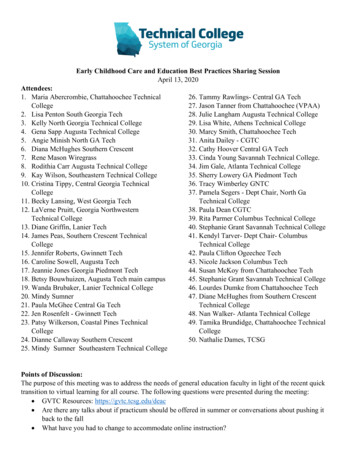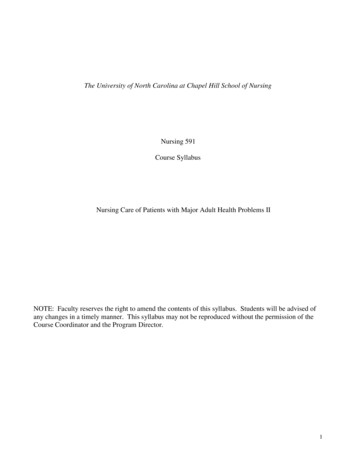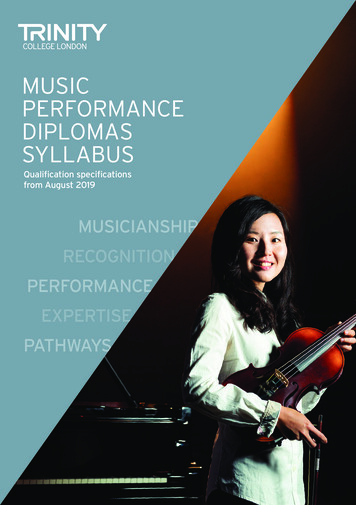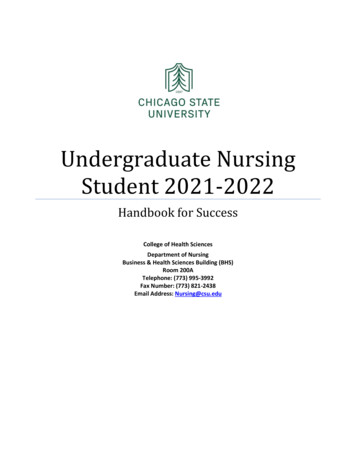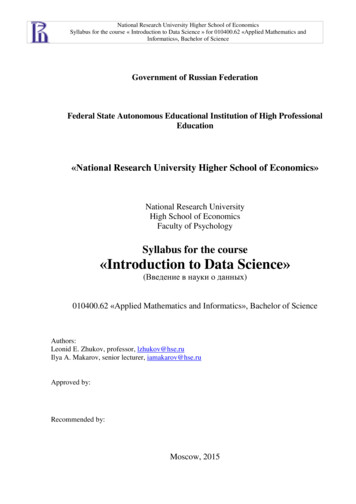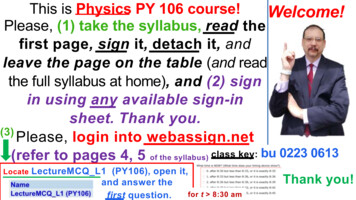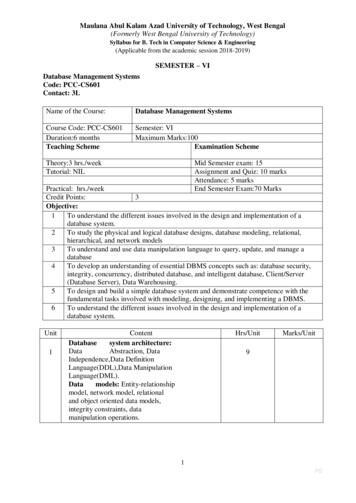
Transcription
Maulana Abul Kalam Azad University of Technology, West Bengal(Formerly West Bengal University of Technology)Syllabus for B. Tech in Computer Science & Engineering(Applicable from the academic session 2018-2019)SEMESTER – VIDatabase Management SystemsCode: PCC-CS601Contact: 3LName of the Course:Database Management SystemsCourse Code: PCC-CS601Duration:6 monthsTeaching SchemeSemester: VIMaximum Marks:100Examination SchemeTheory:3 hrs./weekTutorial: NILMid Semester exam: 15Assignment and Quiz: 10 marksAttendance: 5 marksEnd Semester Exam:70 MarksPractical: hrs./weekCredit Points:3Objective:1To understand the different issues involved in the design and implementation of adatabase system.2To study the physical and logical database designs, database modeling, relational,hierarchical, and network modelsTo understand and use data manipulation language to query, update, and manage a3database4To develop an understanding of essential DBMS concepts such as: database security,integrity, concurrency, distributed database, and intelligent database, Client/Server(Database Server), Data Warehousing.5To design and build a simple database system and demonstrate competence with thefundamental tasks involved with modeling, designing, and implementing a DBMS.6To understand the different issues involved in the design and implementation of adatabase system.Unit1ContentDatabasesystem architecture:DataAbstraction, DataIndependence,Data DefinitionLanguage(DDL),Data ManipulationLanguage(DML).Datamodels: Entity-relationshipmodel, network model, relationaland object oriented data models,integrity constraints, datamanipulation operations.Hrs/UnitMarks/Unit91PG
Maulana Abul Kalam Azad University of Technology, West Bengal(Formerly West Bengal University of Technology)Syllabus for B. Tech in Computer Science & Engineering(Applicable from the academic session 2018-2019)Relationalquerylanguages:Relational algebra, Tuple and domainrelational calculus, SQL3, DDL andDML constructs, Open source andCommercial DBMS - MYSQL,ORACLE, DB2, SQLserver.Relational databasedesign:Domainanddata dependency,Armstrong’s axioms, Normal forms,Dependency preservation,Losslessdesign.Query processing andoptimization: Evaluation ofrelational algebra expressions,Query equivalence, Joinstrategies, Query optimizationalgorithms.13Storage strategies: Indices, B-trees, hashing.3Transaction processing: Concurrencycontrol, ACID property,Serializability of scheduling, Lockingand timestamp based schedulers, Multiversion and optimistic ConcurrencyControl schemes, Database recovery.55Database Security: Authentication,Authorization and accesscontrol,DAC, MAC and RBAC models,Intrusion detection, SQL injection.36Advanced topics: Object oriented andobject relational databases, Logicaldatabases, Web databases, Distributeddatabases, Data warehousing and datamining.3234.Text book and Reference books:1. “Database System Concepts” , 6th Edition by Abraham Silberschatz, HenryF. Korth, S. Sudarshan,McGraw-Hill.2. “Principles of Database and Knowledge – Base Systems”, Vol 1 by J. D. Ullman,Computer Science Press.3. Database Management Systems, R.P. Mahapatra, Khanna Publishing House, NewDelhi (AICTE Recommended Textbook – 2018)2PG
Maulana Abul Kalam Azad University of Technology, West Bengal(Formerly West Bengal University of Technology)Syllabus for B. Tech in Computer Science & Engineering(Applicable from the academic session 2018-2019)4. “Fundamentals of Database Systems” , 5th Edition by R. Elmasri and S. Navathe,5.PearsonEducation “Foundations of Databases”, Reprint by Serge Abiteboul,Richard Hull, Victor Vianu,Addison-WesleyCourse Outcomes:On completion of the course students will be able to1. For a given query write relational algebra expressions for that query andoptimize the developedexpressions2. For a given specification of the requirement design the databasesusing E R method andnormalization.3. For a given specification construct the SQL queries for Open source andCommercial DBMS -MYSQL, ORACLE, andDB2.4. For a given query optimize its execution using Query optimizationalgorithms5. For a given transaction-processing system, determine the transactionatomicity, consistency, isolation, anddurability.6. Implement the isolation property, including locking, time stampingbased on concurrency control and Serializability of scheduling.3PG
Maulana Abul Kalam Azad University of Technology, West Bengal(Formerly West Bengal University of Technology)Syllabus for B. Tech in Computer Science & Engineering(Applicable from the academic session 2018-2019)Computer NetworksCode: PCC-CS602Contact: 3LName of the Course:Computer NetworksCourse Code: PCC-CS602Duration:6 monthsTeaching SchemeSemester: VIMaximum Marks:100Examination SchemeTheory:3 hrs./weekTutorial: NILMid Semester exam: 15Assignment and Quiz: 10 marksAttendance: 5 marksEnd Semester Exam:70 MarksPractical: hrs./weekCredit Points:3Objective:1To develop an understanding of modern network architectures from a design andperformance perspective.2To introduce the student to the major concepts involved in wide-area networks(WANs), local area networks (LANs) and Wireless LANs (WLANs).3To provide an opportunity to do network programming4To provide a WLAN measurement ideas.Unit12ContentData communication Components:Representation of data and its flowNetworks,Various ConnectionTopology, Protocols and Standards,OSI model, Transmission Media,LAN: Wired LAN, Wireless LANs,Connecting LAN and Virtual LAN,Techniques for Bandwidth utilization:Multiplexing - Frequency division,Time division and Wave division,Concepts on spread spectrum.Hrs/UnitData Link Layer and Medium AccessSub Layer: Error Detection and ErrorCorrection - Fundamentals, Blockcoding, Hamming Distance, CRC;Flow Control and Error controlprotocols - Stop and Wait, Go back –N ARQ, Selective Repeat ARQ,SlidingWindow,Piggybacking,8Marks/Unit94PG
Maulana Abul Kalam Azad University of Technology, West Bengal(Formerly West Bengal University of Technology)Syllabus for B. Tech in Computer Science & Engineering(Applicable from the academic session 2018-2019)Random Access, Multiple accessprotocols -Pure ALOHA, SlottedALOHA,CSMA/CD,CDMA/CANetwork Layer: Switching, Logicaladdressing – IPV4, IPV6; Addressmapping – ARP, RARP, BOOTPand DHCP–Delivery, Forwarding andUnicast Routing protocols.Transport Layer: Process to ProcessCommunication, User DatagramProtocol(UDP),TransmissionControl Protocol (TCP), SCTPCongestion Control; Quality ofService, QoS improving techniques:Leaky Bucket and Token Bucketalgorithm.Application Layer: Domain NameSpace (DNS), DDNS, TELNET,EMAIL, File Transfer Protocol (FTP),WWW, HTTP, SNMP, .51488Text book and Reference books:1. Introduction to Algorithms" by Cormen, Leiserson, Rivest, Stein.2. "The Design and Analysis of Computer Algorithms" by Aho, Hopcroft, Ullman.3. "Algorithm Design" by Kleinberg and Tardos.4. Design & Analysis of Algorithms, Gajendra Sharma, Khanna Publishing House, New DelhiCourse Outcomes:On completion of the course students will be able to1. Understand research problem formulation.2. Analyze research related information3. Follow research ethics4. Understand that today’s world is controlled by Computer, InformationTechnology, but tomorrow world will be ruled by ideas, concept, andcreativity.5. Understanding that when IPR would take such important place in growth ofindividuals & nation, it is needless to emphasis the need of information aboutIntellectual Property Right to be promoted among students in general &engineering in particular.6.Understand that IPR protection provides an incentive to inventors for furtherresearch work and investment in R & D, which leads to creation of new andbetter products, and in turn brings about, economic growth and socialbenefits.5PG
Maulana Abul Kalam Azad University of Technology, West Bengal(Formerly West Bengal University of Technology)Syllabus for B. Tech in Computer Science & Engineering(Applicable from the academic session 2018-2019)Advanced AlgorithmsCode: PEC-IT601 AContact: 3LName of the Course:Advanced AlgorithmsCourse Code: PEC-IT601ADuration:6 monthsTeaching SchemeSemester: VIMaximum Marks:100Examination SchemeTheory:3 hrs./weekTutorial: NILMid Semester exam: 15Assignment and Quiz: 10 marksAttendance: 5 marksEnd Semester Exam:70 MarksPractical: NILCredit Points:3Objective:1Introduce students to the advanced methods of designing and analyzing algorithms.The student should be able to choose appropriate algorithms and use it for a specific2problem.3To familiarize students with basic paradigms and data structures used to solveadvanced algorithmic problems.4Students should be able to understand different classes of problems concerning theircomputation difficulties.5To introduce the students to recent developments in the area of algorithmic design.Pre-Requisite:1Algorithm Design and AnalysisUnit12ContentSorting: Review of various sorting algorithms,topological sortingGraph: Definitions and Elementary Algorithms:Shortest path by BFS, shortest path in edge-weightedcase (Dijkasra's), depth-first search and computationof strongly connected components, emphasis oncorrectness proof of the algorithm and time/spaceanalysis, example of amortized analysis.Matroids: Introduction to greedy paradigm,algorithm to compute a maximumweight maximal independent set. Application toHrs/UnitMarks/Unit686PG
Maulana Abul Kalam Azad University of Technology, West Bengal(Formerly West Bengal University of Technology)Syllabus for B. Tech in Computer Science & Engineering(Applicable from the academic session 2018-2019)34.5MST.Graph Matching: Algorithm to compute maximummatching. Characterization ofmaximum matching by augmenting paths, Edmond'sBlossom algorithm to compute augmenting path.Flow-Networks: Maxflow-mincut theorem, FordFulkerson Method to computemaximum flow, Edmond-Karp maximum-flowalgorithm.Matrix Computations: Strassen's algorithm andintroduction to divide andconquer paradigm, inverse of a triangular matrix,relation between the timecomplexities of basic matrix operations,LUP-decomposition.Shortest Path in Graphs: Floyd-Warshallalgorithm and introduction to dynamicprogramming paradigm. More examples of dynamicprogramming.Modulo Representation of integers/polynomials:Chinese Remainder Theorem,Conversion between base-representation andmodulo-representation. Extension topolynomials. Application: Interpolation problem.Discrete Fourier Transform (DFT): In complexfield, DFT in modulo ring. FastFourier Transform algorithm. Schonhage-StrassenInteger Multiplication algorithmLinear Programming: Geometry of the feasibilityregion and Simplex algorithmNP-completeness: Examples, proof of NP-hardnessand NP-completeness.One or more of the following topics based on timeand interestApproximation algorithms, Randomized Algorithms,Interior Point Method,Advanced Number Theoretic AlgorithmRecent Trands in problem solving paradigms usingrecent searching and sorting techniques by applyingrecently proposed data structures.910105Text book and Reference books:1. "Introduction to Algorithms" by Cormen, Leiserson, Rivest, Stein.2. "The Design and Analysis of Computer Algorithms" by Aho, Hopcroft, Ullman.3. "Algorithm Design" by Kleinberg and Tardos.4. Design & Analysis of Algorithms, Gajendra Sharma, Khanna Publishing House, New Delhi7PG
Maulana Abul Kalam Azad University of Technology, West Bengal(Formerly West Bengal University of Technology)Syllabus for B. Tech in Computer Science & Engineering(Applicable from the academic session 2018-2019)Course Outcomes:On completion of the course students will be able to1. Analyze the complexity/performance of different algorithms.2. Determine the appropriate data structure for solving a particular set of problems.3. Categorize the different problems in various classes according to their complexity.4. Students should have an insight of recent activities in the field of the advanced datastructure.Distributed SystemsCode: PEC-IT601BContact: 3LName of the Course:Distributed SystemsCourse Code: PEC-IT601BDuration:6 monthsTeaching SchemeSemester: VIMaximum Marks:100Examination SchemeTheory:3 hrs./weekTutorial: NILMid Semester exam: 15Assignment and Quiz: 10 marksAttendance: 5 marksEnd Semester Exam:70 MarksPractical: NILCredit Points:3Objective:1To introduce the fundamental concepts and issues of managing large volume of shareddata in a parallel and distributed environment, and to provide insight into relatedresearch problems.Pre-Requisite:1Database Management SystemsUnit1ContentHrs/UnitINTRODUCTIONDistributed data processing; What is a DDBS;Advantages and disadvantages of DDBS; Problemareas; Overview of database and computer networkconcepts DISTRIBUTED DATABASEMANAGEMENT SYSTEM ARCHITECTURETransparencies in a distributed DBMS; DistributedDBMS architecture; Global directory issuesMarks/Unit88PG
Maulana Abul Kalam Azad University of Technology, West Bengal(Formerly West Bengal University of Technology)Syllabus for B. Tech in Computer Science & Engineering(Applicable from the academic session 2018-2019)234.56DISTRIBUTED DATABASEDESIGNAlternative design strategies;Distributed design issues;Fragmentation; Data allocationSEMANTICS DATA CONTROLView management; Data security;Semantic Integrity Control QUERYPROCESSING ISSUESObjectives of query processing;Characterization of query processors;Layers of query processing; Querydecomposition; Localization ofdistributed dataDISTRIBUTEDQUERYOPTIMIZATIONFactors governing query optimization; Centralizedquery optimization; Ordering of fragment queries;Distributed query optimization algorithmsTRANSACTION MANAGEMENTThe transaction concept; Goals of transactionmanagement; Characteristics of transactions;Taxonomy of transaction modelsCONCURRENCY CONTROLConcurrency control in centralized database systems;Concurrency control in DDBSs; Distributedconcurrency control algorithms; DeadlockmanagementReliability issues in DDBSs; Types of failures;Reliability techniques; Commit protocols; Recoveryprotocols AlgorithmPARALLEL DATABASE SYSTEMSParallel architectures; parallel queryprocessing andADVANCED TOPICS MobileDatabases, Distributed ObjectManagement, Multi-databases1111864Text book and Reference books:1. Principles of Distributed Database Systems, M.T. Ozsu and PValduriez,Prentice-Hall, 1991.2. Distributed Database Systems, D. Bell and J. Grimson, AddisonWesley, 1992.9PG
Maulana Abul Kalam Azad University of Technology, West Bengal(Formerly West Bengal University of Technology)Syllabus for B. Tech in Computer Science & Engineering(Applicable from the academic session 2018-2019)Course Outcomes:On completion of the course students will be able to1. Design trends in distributed systems.2. Apply network virtualization.3. Apply remote method invocation and objects.Signals & SystemsCode: PEC-IT601CContacts: 3LName of the Course:Signals & SystemsCourse Code: PEC-IT601CDuration: 6 monthsTeaching SchemeSemester: VIMaximum Marks: 100Examination SchemeTheory:3 hrs./weekTutorial: NILPractical: NILCredit Points:Unit1Mid Semester exam: 15Assignment and Quiz: 10 marksAttendance: 5 marksEnd Semester Exam:70 Marks3ContentIntroduction to Signals and Systems :Signals and systems as seen in everyday life, and invarious branches of engineering and science. Signalproperties: periodicity, absolute integrability,determinism and stochastic character. Some specialsignals of importance: the unit step, the unitimpulse, the sinusoid, the complex exponential,some special time-limited signals; continuous anddiscrete time signals, continuous and discreteamplitude signals. System properties: linearity:additivity and homogeneity, shift-invariance,causality, stability, realizability.Examples.Hrs/UnitMarks/Unit31PG
Maulana Abul Kalam Azad University of Technology, West Bengal(Formerly West Bengal University of Technology)Syllabus for B. Tech in Computer Science & Engineering(Applicable from the academic session 2018-2019)234.Behavior of continuous and discrete-time LTIsystems (8 hours)Impulse response and step response, convolution,input-output behavior with periodic convergentinputs, cascade interconnections. Characterizationof causality and stability of LTI systems. Systemrepresentation through differential equations anddifference equations. State-space Representation ofsystems. State-Space Analysis, Multi-input, multioutput representation. State Transition Matrix andits Role. Periodic inputs to an LTI system, thenotion of a frequency response and its relation tothe impulse response.Fourier, Laplace and z- TransformsFourier series representation of periodic signals,Waveform Symmetries, Calculation of FourierCoefficients. Fourier Transform,convolution/multiplication and their effect in thefrequency domain, magnitude and phase response,Fourier domain duality. The Discrete- Time FourierTransform (DTFT) and the Discrete FourierTransform (DFT). Parseval's Theorem. Review ofthe Laplace Transform for continuous time signalsand systems, system functions, poles and zeros ofsystem functions and signals, Laplace domainanalysis, solution to differential equations andsystem behavior. The z-Transform for discrete timesignals and systems, system functions, poles andzeros of systems and sequences, z-domain analysis.TheSamplingTheoremanditsimplications. Spectra of sampled signals.Reconstruction: ideal interpolator, zeroorder hold, first-order hold. Aliasing and itseffects. Relation between continuous anddiscrete time systems. Introduction to theapplications of signal and system theory:modulation for communication, filtering,feedback control systems.81092PG
Maulana Abul Kalam Azad University of Technology, West Bengal(Formerly West Bengal University of Technology)Syllabus for B. Tech in Computer Science & Engineering(Applicable from the academic session 2018-2019)Text book and Reference books:1. A. V. Oppenheim, A. S. Willsky and S. H. Nawab, “ Signalsand systems”,Prentice Hall India,1997.2. J. G. Proakis and D. G. Manolakis, “ Digital Signal Processing: Principles,Algorithms, and Applications” , Pearson,2006.3. H. P. Hsu, “ Signals and systems”, Schaum’sseries, McGraw Hill Education,2010.4. S. Haykinand B. V. Veen, “ Signals and Systems”, John Wiley and Sons,2007.5. A. V. Oppenheim and R. W. Schafer, “ Discrete-Time SignalProcessing”, Prentice Hall,2009.6. M. J. Robert “ Fundamentals of Signals and Systems”, McGraw HillEducation, 2007.7. B. P. Lathi, “ LinearSystems and Signals”, Oxford University Press,2009.8. A. V. Oppenheim and R. W. Schafer, “ Discrete-Time SignalProcessing”, Prentice Hall,2009.9. M. J. Robert “ Fundamentals of Signals and Systems”, McGraw HillEducation, 2007.10. B. P. Lathi, “ LinearSystems and Signals”, Oxford University Press,2009.11. R. Anand, “Signals and Systems, Khanna Publishing House, 2018.Course Outcomes: On completion of the course students will be able toUnderstand the concepts of continuous time and discrete time systems.Analyse systems in complex frequency domain.Understand sampling theorem and its implications.Understand the concepts of continuous time and discrete time systems.3PG
Maulana Abul Kalam Azad University of Technology, West Bengal(Formerly West Bengal University of Technology)Syllabus for B. Tech in Computer Science & Engineering(Applicable from the academic session 2018-2019)Image ProcessingCode:PEC-IT601 DContact: 3LName of the Course:Image ProcessingCourse Code: PEC-IT601DDuration:6 monthsTeaching SchemeSemester: VIMaximum Marks:100Examination SchemeTheory:3 hrs./weekTutorial: NILPractical: NILCredit Points:Unit123Mid Semester exam: 15Assignment and Quiz: 10 marksAttendance: 5 marksEnd Semester Exam:70 Marks3ContentIntroduction [3L]Background, Digital ImageRepresentation, Fundamental steps inImage Processing, Elements of DigitalImage Processing - Image Acquisition,Storage, Processing, Communication,Display.Digital Image Formation [4L]A Simple Image Model, Geometric Model- BasicTransformation (Translation, Scaling, Rotation),Perspective Projection, Sampling & Quantization Uniform & Non uniform.Mathematical Preliminaries[9L]Neighbour of pixels, Connectivity, Relations,Hrs/Unit9Marks/Unit49Equivalence & Transitive Closure; DistanceMeasures, Arithmetic/Logic Operations, FourierTransformation, Properties of The TwoDimensional Fourier Transform, Discrete FourierTransform, Discrete Cosine & SineTransform.4PG
Maulana Abul Kalam Azad University of Technology, West Bengal(Formerly West Bengal University of Technology)Syllabus for B. Tech in Computer Science & Engineering(Applicable from the academic session 2018-2019)4.56Image Enhancement [8L]Spatial Domain Method, Frequency DomainMethod, Contrast Enhancement -Linear &Nonlinear Stretching, Histogram Processing;Smoothing - Image Averaging, Mean Filter,Low-pass Filtering; Image Sharpening. Highpass Filtering, High- boost Filtering,Derivative Filtering, Homomorphic Filtering;Enhancement in the frequency domain - Lowpass filtering, High pass filtering.Image Restoration [7L]Degradation Model, Discrete Formulation,Algebraic Approach to Restoration Unconstrained & Constrained; ConstrainedLeast Square Restoration, Restoration byHomomorphicFiltering,GeometricTransformation - Spatial Transformation,Gray Level Interpolation.8Image Segmentation [7L]Point Detection, Line Detection, Edgedetection, Combined detection, EdgeLinking & Boundary Detection - LocalProcessing, Global Processing via TheHoughTransform;ThresholdingFoundation, Simple Global Thresholding,Optimal Thresholding; Region OrientedSegmentation - Basic Formulation, RegionGrowing by Pixel Aggregation, RegionSplitting & Merging.77Text book and Reference books:1. Hearn, Baker – “Computer Graphics (C version 2nd Ed.)” – Pearson education2. Z. Xiang, R. Plastock – “ Schaum’s outlines Computer Graphics (2nd Ed.)” – TMH3. D. F. Rogers, J. A. Adams – “Mathematical Elements for Computer Graphics (2nd Ed.)” –TMH5PG
Maulana Abul Kalam Azad University of Technology, West Bengal(Formerly West Bengal University of Technology)Syllabus for B. Tech in Computer Science & Engineering(Applicable from the academic session 2018-2019)Parallel and Distributed AlgorithmsCode: PEC-IT602AContacts: 3LName of the Course:Parallel and Distributed AlgorithmsCourse Code PEC-IT602ADuration: 6 monthsTeaching SchemeSemester: VIMaximum Marks: 100Examination SchemeTheory:3 hrs./weekTutorial: NILPractical: NILCredit Points:Unit1234.5Mid Semester exam: 15Assignment and Quiz: 10 marksAttendance: 5 marksEnd Semester Exam:70 Marks3ContentUNIT-I :Basic Techniques, Parallel Computers forincrease Computation speed, Parallel & ClusterComputingUNIT-II :Message Passing Technique- EvaluatingParallel programs and debugging, Portioning andDivide and Conquer strategies examplesUNIT-III :Pipelining- Techniques computing platform,pipeline programs examplesUNIT-IV:Synchronous Computations, load balancing,distributed termination examples, programming withshared memory, shared memory multiprocessorconstructs for specifying parallelist sharing data parallelprogramming languages and constructs, open MPUNIT-V :Distributed shared memory systems andprogramming achieving constant memory distributedshared memory programming primitives, algorithms –sorting and numerical algorithms.Hrs/UnitMarks/Unit888119Text book and Reference books:1. Parallel Programming, Barry Wilkinson, Michael Allen, Pearson Education, 2nd Edition.2. Introduction to Parallel algorithms by Jaja from Pearson, 1992.6PG
Maulana Abul Kalam Azad University of Technology, West Bengal(Formerly West Bengal University of Technology)Syllabus for B. Tech in Computer Science & Engineering(Applicable from the academic session 2018-2019)Data Warehousing and Data MiningCode: PEC-IT602BContacts: 3LName of the Course:Data Warehousing and Data MiningCourse Code PEC-IT602BDuration: 6 monthsTeaching SchemeSemester: VIMaximum Marks: 100Examination SchemeTheory:3 hrs./weekTutorial: NILPractical: NILCredit Points:Unit1234.Mid Semester exam: 15Assignment and Quiz: 10 marksAttendance: 5 marksEnd Semester Exam:70 Marks3ContentHrs/UnitUnit 1:Introduction to Data Warehousing; Data Mining:Mining frequent patterns,association and correlations; Sequential Pattern Miningconcepts, primitives,scalable methods;Unit 2:Classification and prediction; Cluster Analysis – Typesof Data in Cluster Analysis,Partitioning methods, Hierarchical Methods;Transactional Patterns and othertemporal based frequent patterns,Unit 3:Mining Time series Data, Periodicity Analysis for timerelated sequence data, Trend analysis, Similarity searchin Time-series analysis;Unit 4:Mining Data Streams, Methodologies for stream dataprocessing and stream datasystems, Frequent pattern mining in stream data,Sequential Pattern Mining inData Streams, Classification of dynamic data streams,Class Imbalance on for communication,filtering, feedback control systems.Marks/Unit888117PG
Maulana Abul Kalam Azad University of Technology, West Bengal(Formerly West Bengal University of Technology)Syllabus for B. Tech in Computer Science & Engineering(Applicable from the academic session 2018-2019)Unit 5:Web Mining, Mining the web page layout structure,mining web link structure,mining multimedia data on the web, Automaticclassification of web documentsand web usage mining; Distributed Data Mining.Unit 6:Recent trends in Distributed Warehousing and DataMining, Class ImbalanceProblem; Graph Mining; Social Network Analysis95Text book and Reference books:1. Data Warehousing Fundamentals for IT Professionals, Second Edition by PaulrajPonniah, Wiley India.2. Data Warehousing, Data Mining, & OLAP – Second Edition by Alex Berson andStephen J. Smith, Tata McGraw Hill Education3. Data warehouse Toolkit by Ralph Kimball, Wiley India4. Data Mining & Warehousing by Ikvinderpal Singh, Khanna Publishing House5. Jiawei Han and M Kamber, Data Mining Concepts and Techniques,, Second Edition,Elsevier Publication, 2011.6. Vipin Kumar, Introduction to Data Mining - Pang-Ning Tan, Michael Steinbach,Addison Wesley,2006.7. G Dong and J Pei, Sequence Data Mining, Springer, 2007.Course Outcomes:After completion of course, students would be:1. Study of different sequential pattern algorithms2. Study the technique to extract patterns from time series data and it application in realworld.3. Can extend the Graph mining algorithms to Web mining4. Help in identifying the computing framework for Big Data8PG
Maulana Abul Kalam Azad University of Technology, West Bengal(Formerly West Bengal University of Technology)Syllabus for B. Tech in Computer Science & Engineering(Applicable from the academic session 2018-2019)Human Computer InteractionCode:PEC-IT602CContact: 3LName of the Course:Course Code: PEC-IT602CDuration: 6 monthsTeaching SchemeHuman Computer InteractionSemester: VIMaximum Marks:100Examination SchemeTheory:3 hrs./weekTutorial: NILMid Semester exam: 15Assignment and Quiz: 10 marksAttendance : 5 marksEnd Semester Exam :70 MarksPractical: NILCredit Points:3Objective:1Learn the foundations of Human Computer Interaction2Be familiar with the design technologies for individuals and persons with disabilities3Be aware of mobile Human Computer interaction4Learn the guidelines for user interface.Pre-Requisite:1Computer Organization &ArchitectureUnitContent1Human: I/O channels – Memory – Reasoning and problem solving;The computer: Devices – Memory – processing and networks;Interaction: Models – frameworks – Ergonomics – styles – elements –interactivity- Paradigms.Interactive Design basics – process – scenarios – navigation – screendesign –Iteration and prototyping. HCI in software process – software life cycle–usability engineering – Prototyping in practice – design rationale.Design rules– principles, standards, guidelines, rules. Evaluation Techniques –UniversalDesign.Cognitive models –Socio-Organizational issues and stake holderrequirements–Communication and collaboration models-Hypertext,Multimedia and WWW.23.Hrs/Unit9Marks/Unit1189PG
Maulana Abul Kalam Azad University of Technology, West Bengal(Formerly West Bengal University of Technology)Syllabus for B. Tech in Computer Science & Engineering(Applicable from the academic session 2018-2019)4.Mobile Ecosystem: Platforms, Application frameworks- Types ofMobileApplications: Widgets, Applications, Games- Mobile InformationArchitecture,Mobile 2.0, Mobile Design: Elements of Mobile Design,Tools.85.Designing Web Interfaces – Drag & Drop, Direct Selection, ContextualTools,Overlays, Inlays and Virtual Pages, Process Flow. CaseStudies.Recent Trends: Speech Recognition and Translation,Multimodal System86.3Text book and Reference books:1. Theodor Richardson, Charles N Thies, Secure Software Design, Jones & Bartlett2. Kenneth R. van Wyk, Mark G. Graff, Dan S. Peters, Diana L. Burley, Enterprise SoftwareSecurity,Addison Wesley.Course Outcomes:On completion of the course students will be able to1. Differentiate between various software vulnerabilities.2. Software process vulnerabilities for an organization.3. Monitor resources consumption in a software.4. Interrelate security and software development process.10PG
Maulana Abul Kalam Azad University of Technology, West Bengal(Formerly West Bengal University of Technology)Syllabus for B. Tech in Computer Science & Engineering(Applicable from the academic session 2018-2019)Pattern RecognitionCode: PEC-IT602DContact: 3LName of the Course:Pattern RecognitionCourse Code: PEC-IT602DDuration:6 monthsTeaching SchemeSemester: VIMaximum Marks:100Examination SchemeTheory:3 hrs./weekTutorial: NILPractical: NILCredit Points:Unit1234.56Mid Semester exam: 15Assignment and Quiz: 10 marksAttendance: 5 marksEnd Semester Exam:70 Marks3ContentBasics of pattern recognitionHrs/Unit2Bayesian decision theory 8LClassifiers, Discriminant functions, DecisionsurfacesNormal density and discriminant functionsDiscrete features8Parameter estimation methods 6LMaximum-Likelihood estimationGaussian
Database Management Systems, R.P. Mahapatra, Khanna Publishing House, New Delhi (AICTE Recommended Textbook – 2018) Maulana Abul Kalam Azad University of Technology, West Bengal (Formerly West Bengal University of Technology) S




